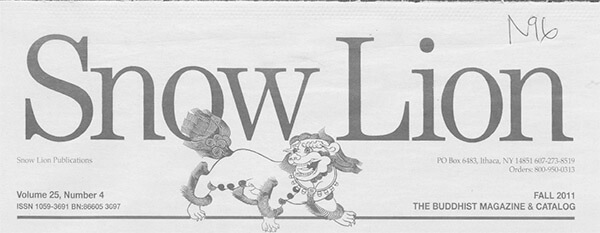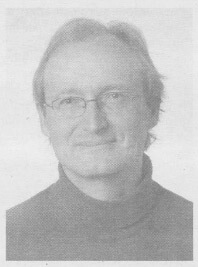| The following article is from the Autumn, 2011 issue of the Snow Lion Newsletter and is for historical reference only. You can see this in context of the original newsletter here. |

An Interview with ANDREW HOLECEK

As founder of the Forum of Living and Dying and the well-known author of The Power and the Pain, Dr. Andrew Holecek teaches seminars throughout the country on spiritual hardship and the Tibetan views of life, death, and beyond.
Jeff Cox: What moved you to write about the pain that happens on the spiritual path ?
Andrew Holecek: There are many books that extol the benefits of practice. They discuss the sunny s'de of meditation. Obviously we need to hear this―otherwise, why would we get involved in something that guarantees hardships?
But during my twenty years as a meditation instructor I started hearing a consistent litany of difficultiesI've talked with many meditators. For this reason I wanted to write something that would encourage people by telling the that they are not alone in their difficulties on the path. This teaching applies particularly to people who are no longer window shopping and have some mileage under them in terms of practice.
JC: People need to see the connections between what comes up in their lives and the effort they are putting into the practice. The very fact of having some challenges is actually a sign of progress.
AH: This is the exactly the case. We could summarize the entire path into one wordrelaxing. Relaxing into the nature of your own mind. However, when we start to relax, the repressed elements of the body/mind come up―it is like a Pandora's box. We discover that there is a reason we repressed these elements in the first place―we did not want to deal with them.
Meditation gives us a second chance to relate to unwanted experience in a healthy way that is based on equanimity and acceptance. It is a second chance to purify karma. In order to wake up, you have to face the shadow side that you have stuffed into your body/ mind.
When you get on the path, you need to realize that you are asking for it! When we get it and are unhappy about it, it is because we didn't read the fine print in the dharma path contract.
These regressive experiences, such as your life falling apart, can be good news. You are starting to get someplace when you come up against barriers of fear and anxiety. What we have been doing our entire lives in these situations is running away from them.
JC: When we're on the path to realizing truth and reality, our own lives have to get truthful and real too.
AH: We all have our spoken and unspoken comfort plans. We might not be able to articulate them, but we have visions of what it means to live a successful life. These are often visions that have been implanted in us by successful marketing agencies. When your ego crashes to the ground, at some point it is no longer useful to try to patch it up again to function at the same level. In chaos theory, systems temporarily break down before they reorganize at a higher level. If we don't understand this process on the spiritual path, we are going to run when the shadow side comes up; this is samsara, running away from reality.
JC: In Jungian psychology, the shadow―the repressed, darker aspects of the psyche―is one of the first things that one has to confront if one is going to break down the ego fortress of strongly held beliefs. Striving to be a good practitioner activates the shadow side in oneself.
For example, let's say there is someone in one's Buddhist class that seems particularly aggravating. It's important to recognize that this person's behaviors represent some of one's own hidden, unintegrated <tendencies.
AH: I am a huge fan of Carl Jung. It doesn't matter whether we call the path spirituality or psychology―however unconscious elements are brought into the light of consciousness, this is part of the liberating process. Trungpa Rinpoche and others recognized that the psychological schools in the West are profound contributors to the process of waking up.
John Wellwood coined the term spiritual bypassing. He addressed the mistake of trying to circumvent psychological problems. The point is that spirituality cannot solve our issues by offering an escape; we can't just hopscotch over them.
In the inner yoga systems, when we say no to experience or reject experience―which is the same as rejecting reality―we stuff that experience into our bodies. We create knots from nots. Engaging in meditation unties these knots and all the refuse is released into one's awareness.
Meditation is not a sedative, it is a laxative! It may sound glib, but much of the spiritual life is learning to say yes to experience. This means to relate to what arises with equanimity. If you can do that, you don't create karma―nothing gets stuffed to fester underneath and rise symptomatically. One of the gifts of Freud and other psychologists is to point out that much of what we do is driven by forces that we are unaware of.

Meditation is not a sedative, it is a laxative! It may sound glib, but much of the spiritual life is learning to say yes to experience.
The primordial emotion of samsara is fear. What is whispered into the subconscious mind all of the time is to avoid fear at all costs. Until we address that fear, everything we do is fear- based. This is why so many authentic traditions are called warrior traditions.
Actually, fear is the indicator of where we should go in order to grow. It is a marker of ignorance; we are afraid of what we don't know. Going into the places that scare you (as Pema Chodron writes) is one of the best ways to become increasingly aware. You use fear as an invitation for genuine spiritual growth.
I also write about this in terms of the five skandhas [the components of the person]. When you look deeply at the first skandha (form), you see how it creates the sense of separateness (ego). We talk about waking up, but I see it as waking down into who we are. This means to cut through the layers of identity that are fear-based. When we drop into this fear, we are approaching the fundamental basis of samsara.
We spend our entire lives running from this emotion. We need to get to know it, make friends with it. The root of the word fear is fare, a toll. Facing fear is the toll we have to pay to become fearless.
JC: Are you saying that we have to go down into the skandas of form, feeling, perception, impulse, and consciousness and realize -what they actually are so that we can become free of the grasping for self in them?
AH: Understanding the skandhas is the basis of understanding how the ego develops. Buddhism doesn't have a developmental psychology per se―how the ego arises. If we understand how the ego forms from the five skandha point of view, we can see how we constantly patch together this illusory thing called self moment by moment. Form skandha is a way of freezing space by self-contracting―this is a way of talking about what ego is. This contraction is based on fear, contracting away from what we don't know. Without some preparation, a practitioner is likely to run from this experience of panic or fear when it comes to the surface.
When we look within we often find demons―we need to see what they are made of, that they are illusory. Otherwise we are setting up a lifelong adversarial relationship with illusions―we are freezing things that fundamentally aren't there. We just need encouragement and support for this process of facing what was formerly unwanted.
JC: Addiction is another way we can frame our tendency to move into habitual patterns that give a sense of comfort and thus avoid the real issues. Addictions do not move us toward happiness, they only numb the pain. And we can be addicted not only to our bad habits, as it were, but also to the things we do to be good or to win. They can be traps as well.
AH: There is no tyranny as great as the tyranny of success, as I discuss in my new book. Being conventionally successful is what Buddhists refer to as entry into the god realm. Unless you keep your wits about you, success inflates the ego. Also, success in meditation―in the sense of the classic experiences of bliss, clarity and non-thought described in Buddhism―can then be set up as a standard for future meditations. And thus we replace our lead chains with golden chains. You have to let these great experiences go! What is important is the complete openness, acceptance and equanimity that brought those experiences about in the first place.
We live in the realm of desire, which is another way of saying we live in the realm of addiction. Every time we repeat an experience, we are creating grooves in our mindscape. These habitual patterns are basically synonymous with ego. Ego is the unskillful habit of looking at reality in terms of self and other. Ego is the archetype of habit―habits give us a sense of solace, stability and security through familiarity. We have to take these unconscious habits based in confusion and transform them into habits of wisdom. That is one way to talk about the entire path. As we practice compassion, equanimity, wisdom and kindness we are cutting new, healthy grooves.
JC: The fundamental habits of perceiving duality―or of looking at the field of experience in terms of desirable, undesirable and neutral―arise out of a fundamental misperception of who we really are. There has to be a shift of identity; we have to see ourselves not as the contracted being but as the vast, open space of buddha nature. Then we begin to explore that space and the development of sane approaches to life―compassion, fearlessness and the rest of it―properly arise from this broader view.

The root of the word fear is fare, a toll. Facing fear is the toll we have to pay to become fearless.
AH: On the path we really are trying to discover who we really are. The first half of the path, so to speak, is about the process of disidentification. We slowly discover who we are not. When we sit in meditation, we are slowly starting to disidentify with our emotions, our thoughts, and our body. We realize there is something deeper; even ordinarily we refer to my body, my emotions, my thoughts. These are possessions and not me.
Then at some point we see who in fact we really are: formless awareness that is saturated with qualities of goodness and love. After seeing this you never see the world in the same way again.
Then the second half of the path is becoming familiar with this seeing: This is who I am, I really am a Buddha. However, the extraordinary power of habitual patterns of passion, aggression, and ignorance continue to trap us. We have to be patient and understand what is going on with these patterns. Equanimity is one of the main ways we can flatten out these habitual patterns and stabilize our realization. We need to be kind to ourselves, persevere, have humor and realize that, just as it took a long time to form them, it will also take a long time to dig ourselves out of the ruts we are in. Understanding this, we can relax and hasten slowly!

